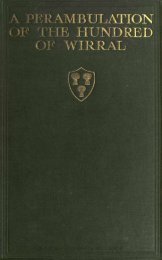Pagan Wirral – Myth or Reality? By Gavin Chappell - Old Wirral.com
Pagan Wirral – Myth or Reality? By Gavin Chappell - Old Wirral.com
Pagan Wirral – Myth or Reality? By Gavin Chappell - Old Wirral.com
You also want an ePaper? Increase the reach of your titles
YUMPU automatically turns print PDFs into web optimized ePapers that Google loves.
The place popularly associated with the Vikings in <strong>Wirral</strong> is Th<strong>or</strong>’s Stone (also<br />
known as Th<strong>or</strong>’s Rock), on Thurstaston Common, a massive block of sandstone that<br />
sits in a natural amphitheatre, surrounded by wood and heathland. Acc<strong>or</strong>ding to local<br />
legend, this ‘gigantic rock altar’ is the site of Viking religious rites in honour of the<br />
thunder god Th<strong>or</strong> <strong>–</strong> the red rock is stained with the blood of victims! <strong>–</strong> <strong>or</strong> else was<br />
raised by the Vikings to <strong>com</strong>mem<strong>or</strong>ate the Battle of Brunanburh in 937 (supposedly<br />
fought at Bromb<strong>or</strong>ough), <strong>or</strong> in a tradition rec<strong>or</strong>ded by Profess<strong>or</strong> Steve Harding in<br />
Ingimund’s Saga, it is the location of Th<strong>or</strong>’s Hammer, the weapon the N<strong>or</strong>se god uses<br />
to defend the w<strong>or</strong>ld from the frost giants. But is there truth in any of these st<strong>or</strong>ies?<br />
No, would appear to be the sh<strong>or</strong>t answer. Writing in Notes & Queries in November<br />
1877, local w<strong>or</strong>thy Sir James Picton brought to the attention of the general populace<br />
the ‘Great Stone of Th<strong>or</strong>’ a ‘very interesting relic of Saxon <strong>or</strong> Danish heathendom.’<br />
Stating that there was no local legend about it, and that local hist<strong>or</strong>ians did not<br />
mention it, he linked the rock with the township in which it was located, suggesting<br />
that it was ‘Th<strong>or</strong>’s Stone,’ and that the name Thurstaston came from Th<strong>or</strong>s-stane-tun,<br />
<strong>or</strong> the town of Th<strong>or</strong>’s Stone. His real agenda was to stop the encroachment of<br />
developers in the area, and the article is directly responsible f<strong>or</strong> Thurstaston Common<br />
be<strong>com</strong>ing a public park rather than a Vict<strong>or</strong>ian housing development.<br />
Regardless of this, the st<strong>or</strong>y grew and grew. The associations between Th<strong>or</strong>’s Stone<br />
and pre-Christian religion were such that in the late nineteen eighties, members of an<br />
<strong>or</strong>ganisation called the Hearth of the Sons of Odin provoked a min<strong>or</strong> fur<strong>or</strong>e when they<br />
‘reclaimed’ the rock f<strong>or</strong> the w<strong>or</strong>ship of Th<strong>or</strong> and other N<strong>or</strong>se gods. Spoilsp<strong>or</strong>t<br />
academics maintain that the association is bogus: ‘Thurstaston’ actually derives from




